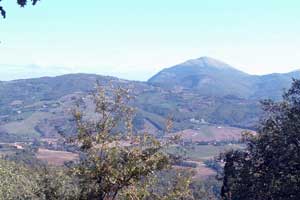|
Who we are
 Ca'
di Bacco is a hamlet placed at the boundary between Umbria and Tuscany,
among olive-trees, 475 metres above sea level. Ca'
di Bacco is a hamlet placed at the boundary between Umbria and Tuscany,
among olive-trees, 475 metres above sea level.
All around, big oak trees draw the boundary with the wood that frames
the property, expanded for one hectare of enclosed land. From the
swimming pool you can enjoy a wonderful view that makes pleasing
even the hottest summer days.
The hill where the hamlet rises,
dominates the valley of the River Niccone extended from East to
West up to the confluence with the Alta Valle del Tevere (Upper
Tiber Valley) from North to South. The hamlet made with stones is
plunged in this land of green valleys, historical centres of great
interest, artistic and religious town. Moreover it's near to the
fourth Italian lake by extension So this is the ideal place for
a peaceful and quiet holiday, in contact with the wonderful nature
of these places.
 However
after only two kilometres of white road you can reach in a short
time the most interesting cities around. Infact the hamlet is situated
midway between the Lake Trasimeno with the nearer Etruscan cities
Chiusi, Cortona, Orvieto and art centers of Umbria Perugia, Assisi,
Gubbio, Spello, Spoleto, Todi and Città di Castello. However
after only two kilometres of white road you can reach in a short
time the most interesting cities around. Infact the hamlet is situated
midway between the Lake Trasimeno with the nearer Etruscan cities
Chiusi, Cortona, Orvieto and art centers of Umbria Perugia, Assisi,
Gubbio, Spello, Spoleto, Todi and Città di Castello.
The spring flowering makes Ca' di
Bacco an unforgettable place, full of wonderful flowers standing
out among various vegetation shades. During the summer the trees'
shade give shelter from the summer's heat. In Autumn and Winter
the majesty of secular oaks bathed in the still of nature makes
the stay always different and interesting. From the swimming pool
built upon the old rural threshing floor, you can see this charming
view: the shape of Monte Acuto (920 metres above sea level) stands
out the horizon line.
 On
its top for a few years there has been the base of an Umbrian-Etruscan
sacrarium, because this zone was a limit between the two cultures.
A short route leads to a hall dug in the ground where divinities
were invoked. Votive statues and other little finds are today exhibited
at the Umbrian Museum of Archaeology in Perugia. On
its top for a few years there has been the base of an Umbrian-Etruscan
sacrarium, because this zone was a limit between the two cultures.
A short route leads to a hall dug in the ground where divinities
were invoked. Votive statues and other little finds are today exhibited
at the Umbrian Museum of Archaeology in Perugia.
|

